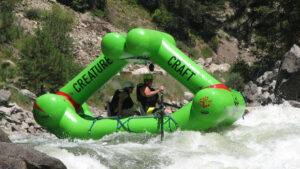The Verdon takes its source near the Col d’Allos in the Trois Évêchés massif at an altitude of 2800 meters. Then it flows into the Durance shortly after Vinon-sur-Verdon. It runs for about 180 km. In this article we will describe the three different sections of the Verdon used by Verdon Xp & The Funny Helmets for its activities.
The Verdon Xp activities in the Upper Verdon
From the sources to the first dam encountered; the one of Castillon (coupled to the dam of Chaudanne), we have to distinguish the section of the Upper Verdon with natural flow (not regulated by a dam). This section can be navigated by Rafting and Canoe. In spring, when the snow melts. But also in autumn thanks to the rains. During the summer, the water flow does not allow navigation but allows some water trekking routes very little exploited. In a wild and Alpine setting (near the Mercantour National Park), this rather narrow stretch of river has made its way between high cliffs. Walls decorated by fabulous geological folds
The Verdon Xp Activities in the Gorges du Verdon
From Castellane to the Pont de Carajuan on the commune of Rougon, the Verdon flows on approximately 15 kilometers. The river bed is wider than in the previous paragraph. In some places, the water has come to perforate the limestone. These are “clues” which allow the water to continue its way. We will pass the clue of the bar Saint Jean then the Clue of Chasteuil. It is a magnificent course which can be practiced in Rafting and Canoe. Only when the flow regulated by the EDF dam of Chaudanne allows it. You will never tire of admiring the landscapes of the Pre-Alps of Provence while sitting on a raft or a canoe. At other times, you can enjoy the song of the cicadas while sunbathing.
Verdon Xp activities in the Grand Canyon du Verdon
From the Carajuan bridge to the Sainte Croix lake, there is one of the most beautiful canyons in Europe and the biggest one at that; the Grand Canyon du Verdon. It is a real cut in the pre-Alpine limestone plateau which can reach 700 meters in depth over a length of 30 kilometers. This exceptional site is particularly difficult to access and the river bed is not very suitable for commercial navigation.
With a flow of more than 10 cubic meters per second
However, with this water level we can stop rafting at Point Sublime. Castellane-Point Sublime is the longest route that can be done. In summer (July-August), we only offer the Chasteuil-Point Sublime route in the late afternoon.)
With a reserved flow (Maximum 3 cubic meters per second)
With a low flow, the Grand Canyon du Verdon is the ideal place to practice aquatic hiking (aqua-rando). On the right bank, at the place called Belvédère du Couloir Samson, there is a half-day course accessible to all. On the left bank, along the Imbut path, there is a one-day aqua trekking course considered by many as the must of the Verdon.
Also, except July 1 – September 15, the reserved flow is 3 cubic meters per second. In this configuration, we can propose the Pont de Soleil-Point Sublime route by kayak. A course less sportive than the classic Castellane-Pont de Soleil but a fabulous course all the same.
See you soon on the fabulous playground of Verdon XP & The Funny Helmets !

